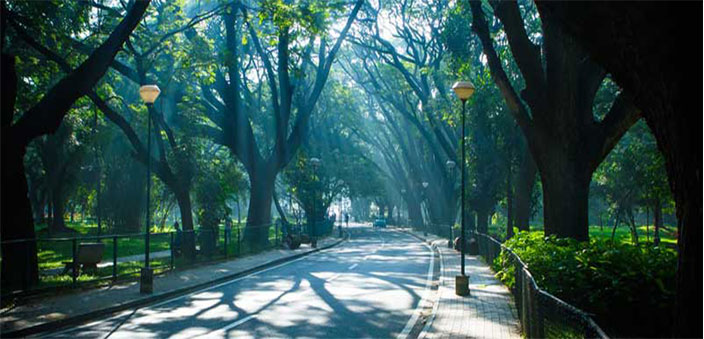Text photos by: Usha Hariprasad
KAt the entrance of the government museum in the city, there stands a six feet high memorial stone retrieved from the premises of a temple in Begur, south of Bangalore. This hero stone describes the battle that took place in an area called Bengaluru. The surprising factor – the inscription mentions 890 AD. The old Kannada epigraph talks about the death of a person named Buttanachetty in the battle.
Bangalore, Bengaluru, whichever name you call it, the city is as old as this, or perhaps even older. Roman coins, Stone Age weapons have been discovered in this area. Quite a number of dynasties have ruled Bangalore – the Gangas, Cholas, Hoysalas, Vijayanagara empire, to name a few.
The origin of the name Bengaluru
There is a fancy story of how the city got its name Bengaluru. A Hoysala King Veera Ballala II got lost in a forest during a hunt. Tired and hungry he reached the hut of an old woman with his horse. She served him boiled beans. In gratitude, the king named the area as Benda-kalu-ooru. This means the ooru or village of boiled beans (benda-kalu). And this happened sometime in 1100 AD. Overtime it became Bengaluru from Bendakalooru. However, there are other explanations too. The name might have come due to the presence of Benga trees (Pterocarpusmarsupium) that grew in abundance in this place.
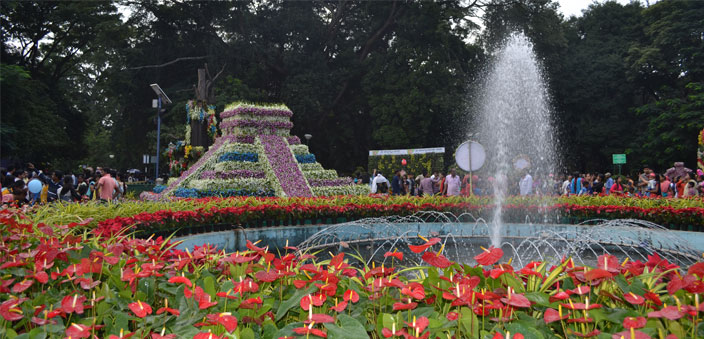
The story of modern Bangalore
Though more than 1,000 years of history of Bengaluru is known, the credit for modern Bangalore goes to a person named Kempe Gowda. He was a chieftain reporting to the Vijayanagara kings, who dominated the South between 1336 and 1565 AD. Their capital was at Hampi, which was a well-planned city bustling with trade. And Kempe Gowda wished to create a capital on similar lines. He set about doing this in Bangalore, near the present Avenue Road-KR Market. Sometime in 1537, he built a mud fort, created a settlement at Bangalore Pete. The Pete community was a community of traders that traded in everything from silk, pearls to grains and vegetables. So way back in the 16th century itself, Bengaluru was cosmopolitan, with different communities and traders conducting business here. Kempe Gowda’s sons were as able as him. His successors built water bodies and watch towers that defined the boundaries of the city.
In 1638, Bangalore came under the control of Bijapur. For a short while until 1687, it was in the hands of the Marathas, after which it came under the control of the Mughals. The Mughals sold Bangalore to a Mysore king named Chikkadeva Raya Wodeyar for three lakh rupees. He built an oval fort south of the existing Pete Fort. In 1759 the region came under Hyder Ali, a foot soldier in the Mysore kingdom, and then later under his son Tipu Sultan. They strengthened the forts – the mud fort became stone-walled, its defences were strengthened.
The British invasion
On March 7 1791, the British army under the command of Charles Cornwallis attacked the Pete Fort and captured it, 15 days later the oval fort fell too. The commander of the fort Bahadur Khan fought bravely, yet was defeated and killed. Some 300-2000 Mysore army men were said to have died in this battle. The forts were seized by the English army and their supplies got replenished. Yet, after a year, the fort was returned to Tipu Sultan. But then in 1799, in the final Anglo-Mysore war, Tipu Sultan was killed and the British captured the city.
Mysore was given back to the Wodeyar kings. For some time the English army stayed at Srirangapatna. But the damp conditions, the mosquitoes did not go well with them, and they decided to shift their garrison. Bangalore was chosen; also because of its cool climate.
The Cantonment
A British Cantonment was set up north east of the Pete, and slowly around 1809, the Bangalore Civil and Military Station came up. The cantonment streets had military nomenclature – Brigade Road, Infantry Road, Parade Road etc. When the railway link between Bangalore East and Madras was established, new settlers especially from Tamil Nadu, arrived in the cantonment. The area now boasted of various communities – Tamils, Muslims, Anglo-Indians. Newer layouts were developed – Benson Town, Fraser Town, Malleshwaram, and Basavangudi.
When the plague struck Bangalore in 1898, sanitation was given priority. Layouts developed with wider roads. At the beginning of the 20th century, between the time period 1881 and 1950, the city boasted of two administrative units – the Pete reporting to the Mysore Maharajas, and the Cantonment reporting to the British. With the coming of Independence and with the departing of English, both cantonment and the native Pete were merged. Bangalore was the capital of Mysore State then, and continued to remain the capital after the States Reorganisation Act of 1956. Newer layouts like Jayanagara, Sadhashivnagar came up in the city.
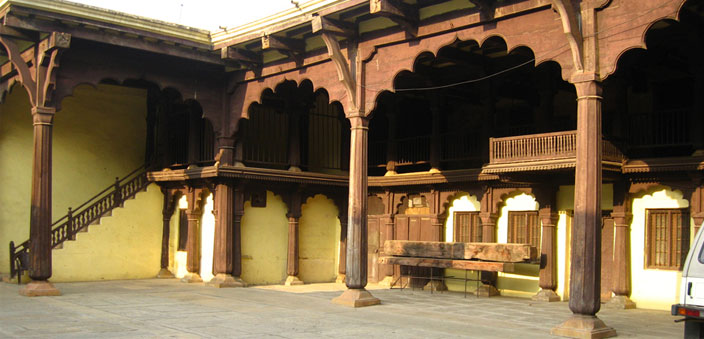
The boom of industrialisation
The 1940-50’s saw the boom of public sector companies. Defence land, climate, and the fact that there were premier technical institutes like the Indian Institute of Science (IISC), triggered this growth. IISC was established in 1909, brought about by Jamsetji Tata and support of Mysore Maharaja. Hindustan Aircraft, HMT, BEL, ISRO, DRDO set up bases here during the 1950s. The city already had an airbase way back in 1940 during World War II. So engineering was not something new to Bengaluru.
1980s saw the setting up of companies like Texas Instruments and other IT companies. The IT boom began, and with it the expansion of Bangalore and the growth of real estate. Today Bangalore has a population of 10 million accommodated in a space of 709 square km. The city got renamed to Bengaluru in 2014.
The city has many names – Garden city, Pensioner’s Paradise, Silicon City, Pub City, to name a few. There is plenty to see with the old and traditional mixing with the new and the modern. So for a new comer visiting the city for the first time, here are a few attractions:
The parks
There are two lovely parks that are not to be missed in the city. Lalbagh – a 240-acre park was built by Hyder Ali in 1760. Though it started out as a Mughal garden and was a 40-acre park, today it has expanded to its current size boasting of 1,845 plant species. The park was expanded by Hyder Ali’s son Tipu Sultan, and after that by British and Indian horticulturists.
Cubbon Park on the other hand is a larger park of around 300 acres, and was constructed during the time of a British commissioner John Meade, in 1864. Today it houses colonial buildings, band stand, and museums. There are more than 6,000 plants in this area boasting of both indigenous species like Ficus and Cassia, and exotic species like Tabebuia and Araucaria.
The palaces
The city boasts of Tipu’s Summer Palace and the Bangalore Palace. Tipu’s Summer Palace is an Indo-Islamic building that served as the summer residence of the Sultan. The building that is made mostly of wood and boasting of ground and upper floors, is a beautiful palace with fluted pillars, cantilever balconies, and floral motifs on the walls. The upper floor served as the durbar too. Today the ground floor has a small museum related to Tipu Sultan.
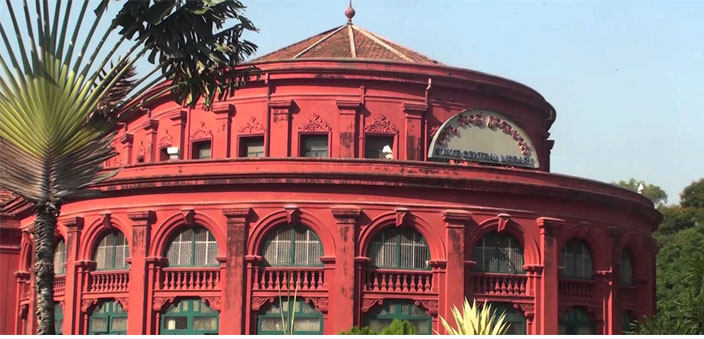
Bangalore Palace is a Tudor style palace complete with turrets, battlements and gothic elements. It was purchased for Chamaraja Wadiyar X, and today boasts of beautiful gardens, ballrooms, moorish courtyards, durbar hall and Raja Ravi Varma’s paintings.
The markets
The K.R Market known as the Krishna Rajendra Market has an interesting past. The venue was once a water tank which then served as a battle field between the British and Mysore army. After the city came into the hands of the British it served as a platform to sell produce. Soon it became a bigger market place – a bustling vegetable and fruit market of today. The red and white structure of yesteryears – 1921 to be precise, still stands today.

Russel Market is another heritage market that came up in 1927. It was named after the Municipal Commissioner T.B. Russel and served the European settlement in the Cantonment areas. Today, it is the venue to head to if you need dates, exotic fruits and meat. The traditional markets of Malleshwaram and Basavangudi are also other markets to explore in the city.
Bangalore’s buildings
Lovely colonial Greco-Roman style buildings dot the city. To name a few – the Attara Kacheri or the High Court, Sheshadri Memorial, Raj Bhavan, Victoria and Bowring Hospital etc. The Attara Kacheri – the present High Court – is located inside the Cubbon Park premises, and was functional in 1868. It housed the State Secretariat until Vidhan Soudha was formed, after which it became the High Court. It is a beautiful building painted in Pompeian red, and was constructed by the engineer Richard Sankey.
Just opposite to this building is the Vidhan Soudha constructed by the then chief minister of Karnataka, Kengal Hanumanthaiah. The foundation stone was laid by Jawaharlal Nehru in 1951. The building in Neo-Dravidian style is the seat of legislature. It is a grand building dwarfing the Attara Kacheri built by the British. The labourers used for building this structure were mostly convicts who were freed once the building was completed in 1956.
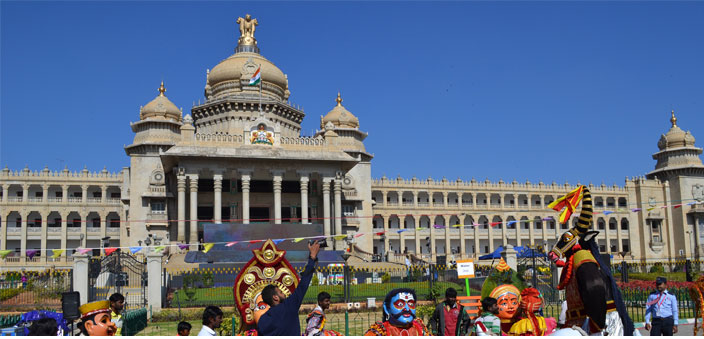
Quite a few bungalows have been taken over as heritage hotels or boutiques. Raintree, an Irish bungalow more than 60 years old, is a boutique that combines old world charm of a bungalow with upmarket lifestyle brands. Casa Cottage is a colourful place turned into a hotel. It is more than 100 years old.
Religious institutions
Ancient temples, dargah-s and churches abound in Bengaluru. Some of the oldest temples in the city are Gavi Gangadhareshwara, Bull Temple, Kadu Malleshwaram, etc. While the Gavi Gangadhareshwara and the Bull Temple at Basavangudi can be attributed to Kempe Gowda’s period, the Kadu Malleshwaram temple at Malleshwaram is ancient, and is not dated. However, an inscription beside it mentions that Venkoji, Shivaji’s step-brother, gave a grant to this temple in the 17th century.

Apart from temples, there are quite a number of old churches in the city. To name a few – Francis Xavier, St. Mark’s Cathedral, Holy Trinity, St. Mary’s Basilica etc. Old mosques like Jamia Masjid, Jumma Masjid, and dargah-s like Tawakkal Mastan reflect the city’s multi-cultural spirit.
Art galleries and museums
For art enthusiasts, the city can be heaven. There are a number of galleries like National Gallery of Modern Art (NGMA), Karnataka Chitrakala Parishat (KCP), Sublime, Venkatappa gallery, etc. Along with paintings, pottery and sculptures also are on display. NGMA that is actually a palace – Manikyavelu Mansion – also includes an art library for the public. Quite a number of these galleries also conduct regular art walks. KCP along with being an art space, is also a centre for the College of Fine and Visual Arts. It also serves as a venue for various exhibitions like handicraft, handlooms and paintings.
A science planetarium – the Jawaharlal Nehru Planetarium, and a science museum – the Visvesvaraya Industrial & Technological Museum – also grace the city, and is a must-visit for kids. The government museum in the premises of Cubbon Park – a heritage building constructed sometime around 1866 and moved here in 1877, is an archaeological museum boasting of sculpture, inscriptions, pottery from various periods like Ganga, Hoysala, Vijayanagara, etc. Mayo Hall located at MG Road is another worthy museum. It displays exhibits that talk about Kempe Gowda, his lineage, and his achievements.
Bangalore’s food haunts.
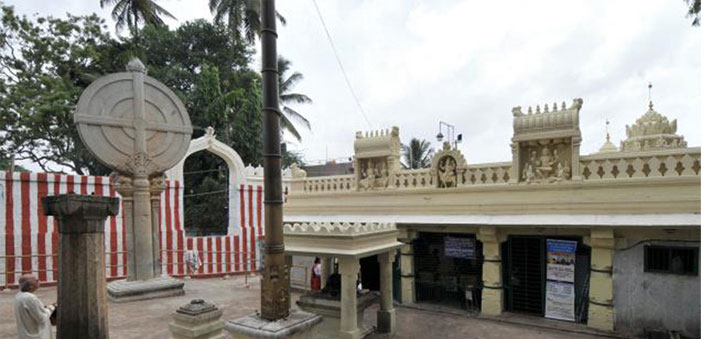
There are some lovely old restaurants that serve out the best dosa-s in the city. CTR that stands for Central Tiffin Room in Malleshwaram started sometime in the early 20th century, serves one of the best butter masala dosa-s in town. Vidyarthi Bhavan in Basavangudi, MTR near Lalbagh, are other contenders for dishing out the best masala dosa-s. Bangalore also has its own food gali – the V.V. Puram food street.
This gali is mainly active during night. Dal holige, Gulkand ice cream, dosa-s, fried snacks of hyacinth beans, congress buns, are some not to be missed items. So venture into this street with an empty stomach, or rather, skip a meal or two, and then stroll through this lane. For the best idli-s head to Veena Stores and Brahmin’s Coffee Bar. For chaat-s and sandwiches, Sri Sairam at Malleshwaram, Hari’s Sandwich Zone in Jayanagar, are some favourite haunts.
Guided walks and tours
One of the best ways to explore a city is not through guide books, but rather through guided walks. Generally conducted by history buffs or heritage enthusiasts, it is a beautiful way to travel the city like a local.
There are a number of organisations that conduct heritage walks in the city. A couple of them worth mentioning are Bangalore Walks, Unhurried, Indian National Trust for Art and Cultural Heritage or INTACH .These walks showcase different parts of the city, and engage people through stories. Apart from heritage walks, there are walks dedicated solely to food in the city like the Oota Walks that take you on a gastronomic tour. Day tours, half a day tours are also conducted by some of these organisations. For day tours outside the city you can book yourself a tour at Karnataka State Tourism Development Corporation (KSDTC). Heritage sites like Belur, Halebidu, Hampi, and Shravanabelagola get covered under these bus packages.

